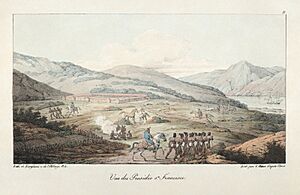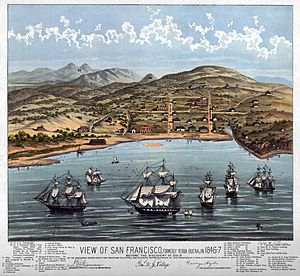Yerba Buena, California facts for kids

Yerba Buena was the original name for the city we now know as San Francisco, California. It started as a small anchorage (a safe place for ships to drop anchor) and then grew into a town. The name "Yerba Buena" means "good herb" in Spanish. It came from a plant, Clinopodium douglasii, that grew a lot in the area. The town was founded in 1834. It was located on the San Francisco Peninsula, right by Yerba Buena Cove.
Yerba Buena was the first civilian town, or pueblo, in San Francisco. Before this, there were only settlements for native people, missionaries, or the military. It was first planned as a trading post for ships visiting San Francisco Bay. The town was built around a central square, called a plaza, which is now Portsmouth Square. Today, the old Yerba Buena area is part of San Francisco's Financial District and Chinatown.
Contents
The Story of Yerba Buena
How Settlements Started in California
When Spain and later Mexico ruled Alta California (which is now California), they created four main types of settlements:
- Missions: These were religious centers run by Franciscan priests. Their goal was to teach Christianity to the native people.
- Presidios: These were military forts. They protected the missions and Spanish lands. They also helped control the native population.
- Pueblos: These were civilian towns. Three early pueblos were created: San José (1777), Los Ángeles (1781), and Branciforte (1797). People were brought from Mexico to live in these towns.
- Ranchos: These were large areas of land given out as grants. They were mostly used for grazing animals. Many more ranchos were created after the missions lost their land in 1833.
Over time, during Mexico's rule, the missions and presidios became less important. But the ranchos and pueblos grew much larger.

The first Spanish settlements in San Francisco began in 1776. The Presidio of San Francisco was founded in September near the Golden Gate. Then, Mission San Francisco de Asís was founded in October. It was built to gather the Ohlone and Miwok people and convert them to Christianity. For a long time, there were no other civilian towns in San Francisco. This changed after Mexico's Secularization Act of 1833.
The Place of the Good Herb
The empty northeastern part of San Francisco was called El Paraje de Yerba Buena. This means "The Place of the Good Herb." Paraje means "place" or "stopping point." Yerba buena is a Spanish name for mint plants. In California, it referred to Clinopodium douglasii, which grew everywhere there.
Ships visiting San Francisco had a few places to anchor. The first was near the Presidio. But the Yerba Buena anchorage became more popular. It was safer and more protected from the wind. The Yerba Buena anchorage actually moved. It was first near North Point, then later moved a bit south to Yerba Buena Cove. The name "Yerba Buena" also spread to the island facing the cove, which is now Yerba Buena Island.
In 1792, explorer George Vancouver sailed into San Francisco Bay. He wrote in his log that he anchored "in a place they called Yerba Buena." By 1824, ships often chose Yerba Buena Cove as their main stopping point. In 1797, the Spanish built a small fort, the Bateria de Yerba Buena, to protect the anchorage. But it was only used for a short time.
Yerba Buena Becomes a Mexican Town
In 1833, Mexico passed a law called the Mexican Secularization Act of 1833. This law made the missions give up their large landholdings. It also freed the native people who had been under their control. Because of this, Governor José Figueroa allowed civilians to settle in San Francisco. So, in 1834, the town, or pueblo, of Yerba Buena was officially founded by Yerba Buena Cove.
In 1835, William A. Richardson built a home near the cove. He was an English man who had become a Mexican citizen. With the help of Alcalde Francisco de Haro, he planned the streets for the growing town. It kept the name Yerba Buena.
In 1841, James Douglas from the Hudson's Bay Company (HBC) set up a trading post in Yerba Buena. The HBC was a British company. They bought a large building by the water. The post sold goods from Canada, like salmon and lumber. They traded these for animal hides and fat. This also helped improve relations between the British and the Mexican government. However, the HBC closed its Yerba Buena store in 1842. It was sold in 1846, just two years before the California Gold Rush. The Gold Rush quickly turned Yerba Buena into a major city.
American Takeover and New Name
On July 7, 1846, during the Mexican–American War, US Navy Commodore John D. Sloat claimed California for the United States. Two days later, US Navy Captain John Berrien Montgomery arrived in Yerba Buena. He raised the American flag over the town plaza. This plaza is now called Portsmouth Square, named after his ship, the USS Portsmouth.
On July 31, 1846, Yerba Buena's population doubled! About 240 Mormon settlers arrived on a ship called the Brooklyn. They were led by Sam Brannan. In August 1846, Lt. Washington Allon Bartlett became the new leader, or alcalde, of Yerba Buena. On January 30, 1847, Lt. Bartlett announced a big change: Yerba Buena would now be called San Francisco.
California officially became a US military territory in 1848. This happened because of the Treaty of Guadalupe Hidalgo, which ended the Mexican-American War. California became a US state on September 9, 1850. Soon after, San Francisco was made both a City and a County.
Yerba Buena Today
The name Yerba Buena is still used in San Francisco today for several places:
- Yerba Buena Island: This island has kept its name since the Spanish era. For a while, from 1895 to 1931, it was called Goat Island.
- Yerba Buena Gardens: This is a large area of parks, museums, theaters, and shops. It includes the Yerba Buena Center for the Arts. It was created in 1993 in the South of Market (SoMa) area.
- Yerba Buena District: This is a specific area around Yerba Buena Gardens. It is part of the SoMa neighborhood.
- Yerba Buena Avenue: This street runs through the St. Francis Wood and Westwood Highlands neighborhoods in southwestern San Francisco.


